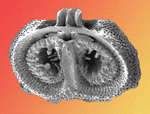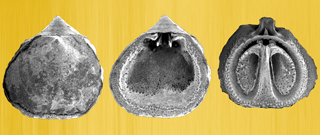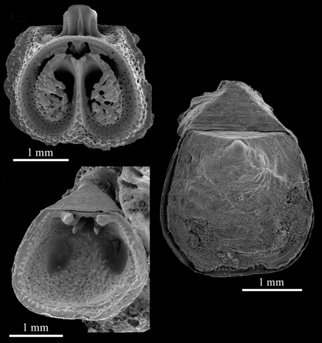|
Thecidellina barretti (Davidson, 1864)
Type locality: North east coast of Jamaica (110 m)
Depth range: 20 - 298 m
Range: Pliocene - Holocene
Thecidium barretti Davidson, 1864, p. 17
Thecidellina barretti (Davidson): Thomson, 1915, p. 462
Thecidellina bahamiensis Lüter et Logan, 2008
Diagnosis - Lüter, Hoffmann & Logan (2008)
Ventral valve with slight frontal sulcus
Ventral valve interior with hemispondylium lifted from floor of ventral valve cavity, unsupported by median ridge
Ventral valve interior smooth or sparsely tuberculate
Dorsal valve interior with interbrachial lobes without canopying spicules but with ridges of calcitic lamellae, causing striping
Dorsal valve interior with roundish opening at caudal end of median septum, flanked by pair of nephridiopore slits
Dorsal valve interior with central median septum, wide anteriorly, tapering slightly posteriorly
Dorsal valve interior with brachidial bridge supported by triangular calcitic pole with irregular outgrowths
|
Diagnosis - Hoffmann & Lüter, (2010)
Average-sized Thecidellina. Ventral valve floor smooth or sparsely tuberculated; hemispondylium lifted from valve floor; interarea with long parallel growth lines; pseudodeltidium absent. Dorsal valve median septum broad with tuberculated crest, posteriorly slightly tapering; interbrachial lobes without canopying spicules; broad calcitic connection between intrabrachial ridge and brachial bridge formed by median outgrowth of brachial bridge; mouth opening round, on either side with slit-like holes; calcitic pole triangular, fused to median lobe of cardinal process, with long irregular caudal outgrowths (= spur); cardinal process with more or less prominent median lobe.
|
|
|
Thecidellina maxilla (Hedley, 1899)
Type locality: Funafuti atoll, Tuvalu (73-146 m)
Depth range: 9 - 356 m
Range: Miocene - Holocene
Thecidea maxilla Hedley, 1899, p. 508
Thecidellina australis maxilla (Hedley): Pajaud, 1970
Diagnosis - Hedley (1899)
Shell small, of variable contour, somewhat boat shaped, attached to stones, shells, or the like, by the beak of the pedicle valve. Colour, dull pale yellow. Sculpture - both valves marked by delicate concentric growth lines and microscopically shagreened.
Ventral valve deep, hinge line straight, cardinal area triangular, apex rather recurved. Margin finely granulate, frequently emarginate in front. Protruding from beneath the hinge are two slender prongs arising from a deep seated septum. External to these, and just beneath the hinge line, are two heavy, projecting, wedge-shaped cardinal teeth. The interior of the valve is irregularly studded with sharp points and tubercles arranged longitudinally, and varying in different individuals.
Dorsal valve externally horse-shoe shaped, and has It slight median boss. Internally it has a straight hinge line, from beneath which and in the plane of the valve, projects a stout cardinal process, whose transverse vertical section would form an omega, hollow downwards. On either side of the cardinal process, and corresponding to the teeth of the lower valve, are two deep triangular impressions, the sockets. All the free edge of the upper valve is granulated. The frontal emargination gradually passes into a funnel directed backwards; here originates the median septum which tapers distally to an acicular point before the hinge. The ventral face of the septum is hollow, on the right and left of it are produced curled flanges with serrate edges. These edges vary much; in some, presumably old, individuals they project irregular jagged lobes into the cavity.

|
After Cooper (1954)
Shell large for the genus, longer than wide and with an elongate oval outline, the beak forming the narrow end. Shell attached by the beak of the pedicle valve and usually in an upright position. Hinge slightly less than the greatest shell width, which is about at the middle. Both valves marked by concentric growth wrinkles.
Ventral valve with interarea long, equaling more than one-third of valve length; interaera smooth and elongate triangular. Lateral profile gently convex; anterior profile narrowly rounded; umbo more or less irregular and occupied by the scar of attachment. Median region swollen; sides narrowly rounded and steep. Teeth large and having strong, thick dental ridges; hemispondylium a long rounded tubular plate with two stout processes at the distal end; hemispondylium apparently free above delthyrial cavity and not attached to floor of valve.
Dorsl valve with short and deeply concave cardinal process; socket ridges not well developed; granulated margin narrow, elevated toward the posterior; lophophore groove narrow and deep; bridge elevated and broad, almost hiding the cardinal process when viewed from the pedicle valve; median septum high and thin, with the lophophore groove located on its sides about midway in the direction of the brachial valve. Space between lophophore grooves occupied by elaborate nodes and irregular processes. Posterior chamber large, with smooth walls; opening into chamber at posterior end of septum small, openings just anterior to cardinal process large.
|
|
|
Thecidellina blochmanni Dall, 1920
Type locality: Christmas Island (10°S, 105°40'E) (84 m)
Depth range: 10 - 1463 m
Thecidea blochmanni Dall, 1920, p. 283
Thecidellina australis blochmanni Dall: Pajaud, 1970
Thecidellina sp. indet. : Logan et al., 2008, p. 302, fig. 2H.
Diagnosis from Logan et al. (2015)
Cardinal process of dorsal valve with prominent median keel, large diductor scars with elevated median ridge, massive calcitic formations (“bouffant-style”) in anterior part of brachial lobes.
|

Interior of a Dorsal valve - after Logan et al. (2015) modified
Dall (1920) states:
"This is nearest to T. maxilla but is much more regular, the
internal arrangements symmetrical, bilaterally identical, and elegant."
|
|
|
Thecidellina japonica (Hayasaka,1938)
Type locality: off Hatizyo-zima, Japan (33°05'N, 139°50'E)
Depth range: 150-183 m
Thecidellella japonica Hayasaka, 1938, p. 9
Diagnosis - Hayasaka (1938)
A very small species, the largest ventral valve at hand measuring about 4 mm in length and width; smaller ones are haif as large. Ventral valve is ornamented with concentric growth !ines externaIly: dorsal valve is rather smooth. Both valves are thick and massive. Ventral valve is slightly asymmetric bilaterally; it is finely granulose intemally and especially marginally. Cardinal area is triangular and fiat, without a pseudodeltidium. Cardinal teeth are small and low, and their inner margins are straight and paraIlel, sa as ta form a squarish space in front of the triangular, fiat cardinal area. Project. ing from beneath the hinge is a pair of sIen der prongs of which only one is preserved in one of the specimens. The interior of the valve is provided with a median septum associated with a number of shorter but sharper ridges and points arranged in two or three irregular longitudinal series on bath sides of the median septum: these lateral ridges do not extend 30 far anteriorly as the median septum does.
Dorsal valve is characterized by its long and high median septum, reaching posteriorly to the "reversed spondylium". The surface of the latter is rough with brachial impressions, and a few sharp prongs project obliquely from the surface of the septum as weIl as of the median part of the "reversed spondylium". The visceral cavity is deep. On each side of the septum a kidney shaped impressions of brachia is found, being represented by a number of antero-laterally diverging brachial lamellae: these lamellae end in sharp points, and decide the raised margin of the kidney-shaped areas of brachial impressions. Outside this is a sharp, continuous raised edge of the coarsely punctate border of the valve which, in front, unites from both sides to form the septum, and which, in the cardinal margin, is raised and makes a bridge over the visceral cavity in front of the cardinal process. The squarish cardinal process is raised medially; there is a small filament rising from above the median ridge of the cardinal process, supporting the bridge like a pillar.
|
|
|
|
Thecidellina congregata Cooper, 1954
Type locality: S of Bikini Atoll, Marshall Islands (91 m)
Depth range: 60 - 439 m
Diagnosis - Cooper (1954)
Small, but of about medium size for the genus; white to blue gray; attached by nearly the entire surface of the pedicle valve; shape variable as usual with attached forms, most specimens wider than long and polygonal in outline; deepest just anterior to the beak of the brachial valve. Hinge narrow.
Ventral valve with only the apical region visible; interarea small, sharply triangular; palintrope plane, descending at an angle from the commissure ranging from 90 to about 30 degrees, but"steep in most speci- mens. Interior of pedicle valve with large teeth buttressed by strong dental ridges; hemispondylium attached to the floor of the valve in the delthyrial chamber and consisting of two short nearly vertical plates bearing sharply pointed processes; adductor scars located in deep, elongate pits on each side of the valve just anterior to the delthyrial cavity.
Dorsal valve provided with a short, broad triangu- lar plane apical interarea. Gently convex in lateral and anterior profiles. Interior with thick narrow and strongly elevated quadrangular cardinal process; sockets moderately deep; bridge thin; septum strongly elevated; valve margin granulated; a deep, narrow trough inside the granulated margin running around the anterior side of the bridge and terminating on the flanks of the median septum at about the middle of the valve; narrow trough occupied by lophophore; posterior occupied by a chamber located just anterior to bridge and at posterior end of median septum; entrance to chamber located on anterior side of bridge at its middle and at posterior end of median septum, the "reversed spondylium" of Hayasaka; posterior side of bridge and just anterior to cardinal process marked by deep pit divided by a small septum. Area between lophophore groove and median septum occupied by a curving row of protruberances rising in height from mere nodes to erect processes which may have served as straining devices.
|
|
|
|
Thecidellina bahamiensis Lüter et Logan, 2008
Type locality: Green Cay, Tongue of Ocean, Bahamas (110 m)
Depth range: 20 - 150 m
Diagnosis - Lüter, Hoffmann & Logan (2008)
Ventral valve with frontal sulcus in some specimens
Ventral valve interior with hemispondylium base supported by median ridge, connecting plate and gonadal pits often obscured by spiculate sub-floor
Ventral valve interior heavily spiculate, forming almost continuous sub- floor in many specimens; strongly tuberculate
Dorsal valve interior with interbrachial lobes with single canopying spicules
Dorsal valve interior with roundish opening at caudal end of median septum, flanked by pair of almost invisible nephridiopore openings
Dorsal valve interior with narrow, almost parallel-sided median septum, tapering to a sharp point posteriorly
Dorsal valve interior with brachidial bridge supported by triangular calcitic pole with irregular outgrowths
|
|
|
|
Thecidellina williamsi Lüter et Logan, 2008
Type locality: São Tiago, Tarrafal, Cape Verde (12 m)
Depth range: 12 - 150 m
Diagnosis - Lüter, Hoffmann & Logan (2008)
Ventral valve with no frontal sulcus
Ventral valve interior with hemispondylium attached to and supported by massive tuberculate median ridge broadening anteriorly and flanked by deep gonadal pits
Ventral valve interior smooth or sparsely tuberculate
Dorsal valve interior with interbrachial lobes with single canopying spicules
Dorsal valve interior with prominent rectangular opening at caudal end of median septum, flanked by pair of kidney-shaped nephridiopore openings
Dorsal valve interior with narrow median septum, tapering to a blunt end posteriorly
Dorsal valve interior with brachidial bridge supported by smooth, narrow parallel-sided pole with no outgrowths
|
see photo below |
|
|
Thecidellina meyeri Hoffmann et Lüter, 2009
Type locality: Curacão, Coralspecht: 12°04'44-40"N 68°53' 49.20"W (24 – 25 m)
Depth range: 13 - 30 m
Thecidellina? barretti: Jackson et al., 1971.
Diagnosis - Hoffmann & Lüter (2009)
Large sized thecideide brachiopod. Dorsal valve intrabrachial ridge and brachial bridge not or slightly coalesced omitting a visceral gap; cardinal process massive, but very short. Ventral valve flat and roundish to deep and elongated; calcitic plate of hemispondylium ventrally not connected to ventral valve floor, arising from posterior or upper wall; prongs slender, exceptionally long, reaching beyond outer margin of ventral valve and teeth; ventral valve floor smooth; median ridge absent or only indicated.
|
|
|
|
Thecidellina insolita Hoffmann, Klann et Matz, 2009
Type locality: Great Barrier Reef, Australia: 14°34'28"S 145°36'84"E (7-12 m)
Depth range: 4 - 12 m
Diagnosis - Hoffmann, Klann & Matz (2009)
Ventral valve pseudodeltidium absent; gonad pits forming deep depressions on either side of hemi-spondylium. Dorsal valve prof ile posteriorly ascending;
calcitic pole not entirely fused to floor of cardinal process, cone-like; visceral foramen only partially divided by calcitic pole; lateral adductor muscle scars extending beyond insertion of cardinal process; brachial bridge broad with well-defined lophophore muscle scars, ovarial notches absent; visceral gap unclosed; median septum broad, anteriorly slightly diverging, con- cavoconvex; marsupial orifices well-defined, large; brachial cavity uncovered or partly covered by single mass of canopying spicules; body wall with additional perforations.
|
|
|
|
Thecidellina europa Logan, Hoffmann et Lüter, 2015
Type locality: Cave in Anse Gabriel, Île Europa (France), Mozambique Channel, at 55 m.
Europa Isl. belongs to the Scattered Islands in the Indian Ocean (French: Îles Éparses de l'océan Indien) part of the French Southern and Antarctic Lands (TAAF).
Depth range: 55 m
Thecidellina cf. blochmanni Dall: Baker & Logan, 2011
Thecidellina cf. blochmanni Dall: Logan & Baker, 2013
Diagnosis - from Logan, Hoffmann & Lüter (2015)
Medium-sized shell, large cardinal process, calcitic plate of hemispondylium attached to valve floor, .long slender prongs, median septum broad, tuberculate, slightly grooved and widening at anterior end, ascending and tapering posteriorly, with prominent ridge at posterior end, no heavy development of calcitic deposits on anterior floor of dorsal valve, spiculate canopy rare.
|

External view - Ventral valve and Dorsal valve (interior)
from Logan et al. (2015) modified
|
|
|
Thecidellina mawaliana Simon, Lüter, Logan et Mottequin, 2018
Type locality: “Mawali” shipwreck (1°26’47”N, 125°13’32”E), Sulawesi, Indonesia.
Depth range: 25 - 30 m.
Diagnosis - from Simon et al. (2018)
Small-sized species. Elongated drop-like ventral valve with striated, triangular, flat
planodeltidium. Hemispondylium arising from posterior part of the valve, connected to the ventral valve floor for
only a short part of its length, with long and slender prongs acutely pointed reaching the level of the cyrtomatodont
teeth.
Ventral valve floor without median ridge, very coarsely tuberculate except in the deep ovate gonad pits,
which have a smooth surface.
Dorsal valve lid-like. Brachial bridge and intrabrachial ridge firmly connected by
wide posterior outgrowths. Calcitic pole, thick, attached to dorsal valve floor and connected with anterior
expansions to the posterior parts of the brachial bridge in fully adult specimens. Median septum high, thin, with
acute tip, ventrally convex, tuberculate-spinous on ventral surface. Brachial cavities or brood pouches covered with
thin, fragile irregular canopying spicules that become fused together through ontogeny but leaving always a lot of
randomly disposed small cavities at maturity.
|

Dorsal and Ventral valves (interior) - External view
from Simon et al. (2018)
|
|
|
Thecidellina leipnitzae Simon, Hiller, Logan & Mottequin
, 2019
Type locality: Submarine cave at 23 m depth situated at "La Passe bateau" off the SW coast of the Island of Mayotte (France) in the second coral reef barrier - 12°58'39.36"S, 44°58'57.72"E
Depth range: 23 m
Diagnosis - from Simon et al. (2019)
Small-sized Thecidellina species, subtriangular to drop-like in outline. Flat, triangular planodel- tidium with densely striated surface. Hemispondylium made of two subparallel prongs anteriorly ended by two curved pointed edges. Ventral valve floor without median ridge and covered with very rough tubercles except in the gonad pits, which have a smooth surface. Lateral ventral valve floor covered with regular subparallel rows of cup- like tubercles. Cyrtomatodont teeth short, blunt. Lid-like slightly convex dorsal valve with prominent protegulum. Very wide, thick dorsal septum with flat ventral surface. Brachial bridge and peribrachial ridge connected by two posterior outgrowths to the intrabrachial ridge. Calcitic pole variable but generally thick. Intrabrachial ridge oval, regular with smooth margins. Brachial cavities or brood pouches in adults partly covered by radially disposed, irregular spicules leaving a free space between each, rarely cemented together in their anterior part. No real canopies over the brachial cavities are observed in this species.
Additional characters: dioecious; female with brooding patterns; schizolophous lophophore.
|
|






